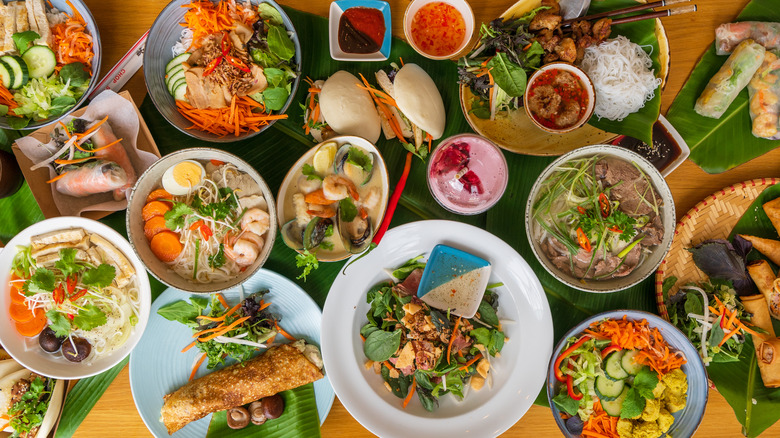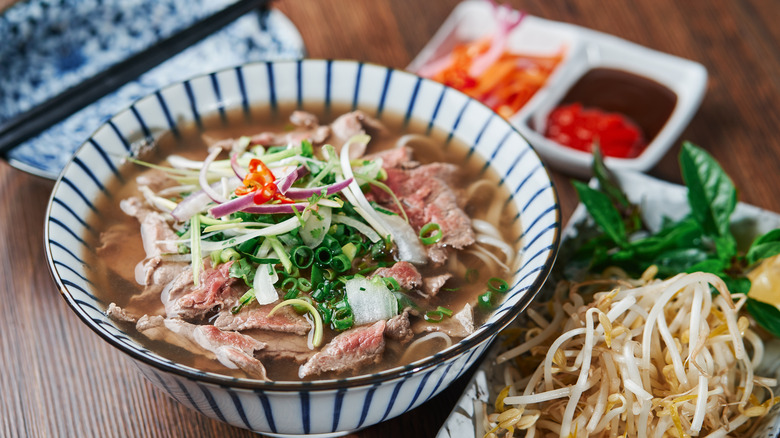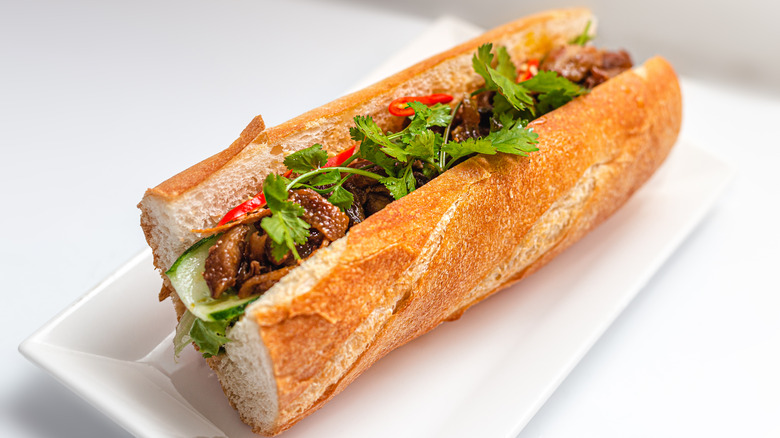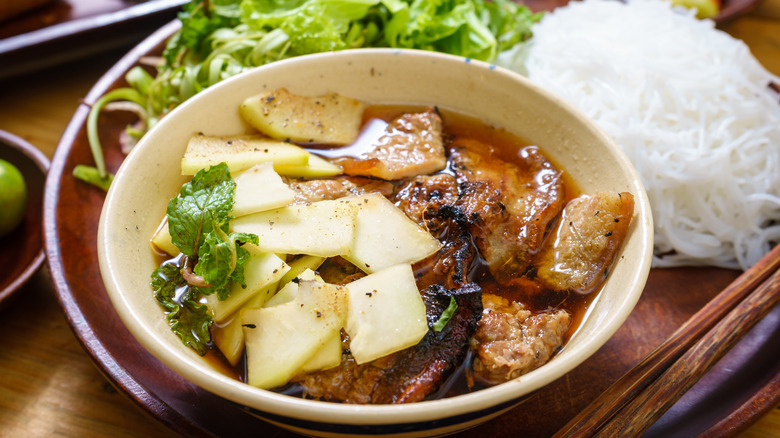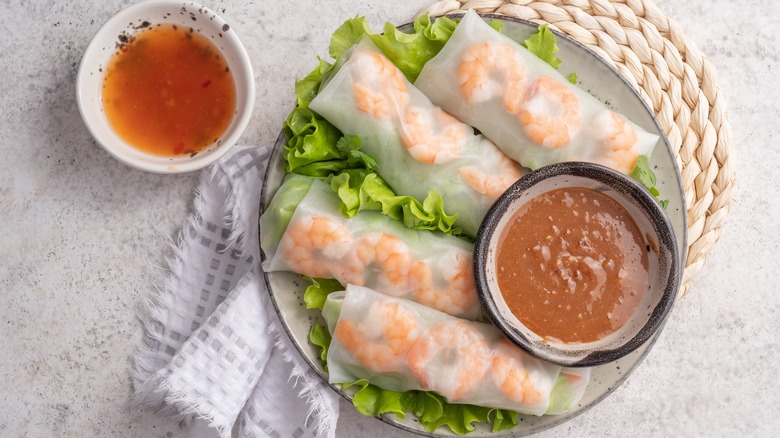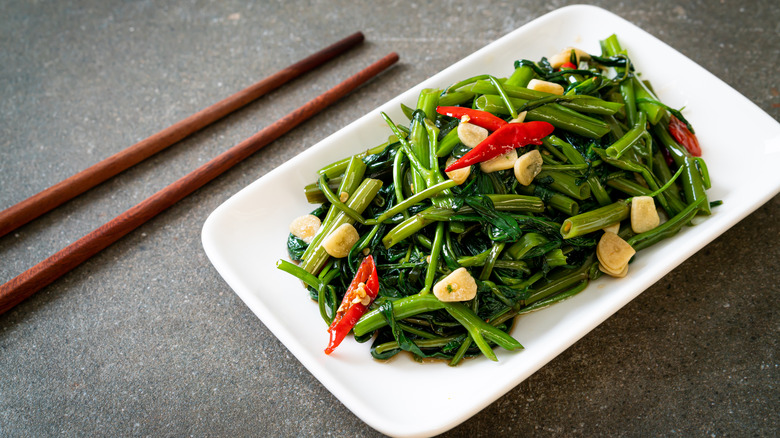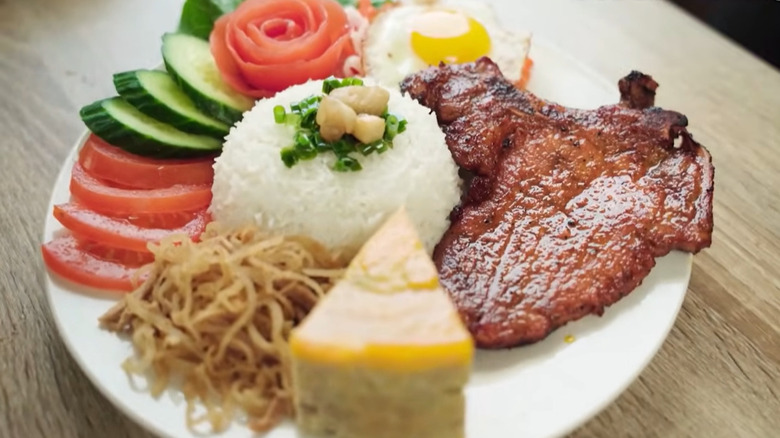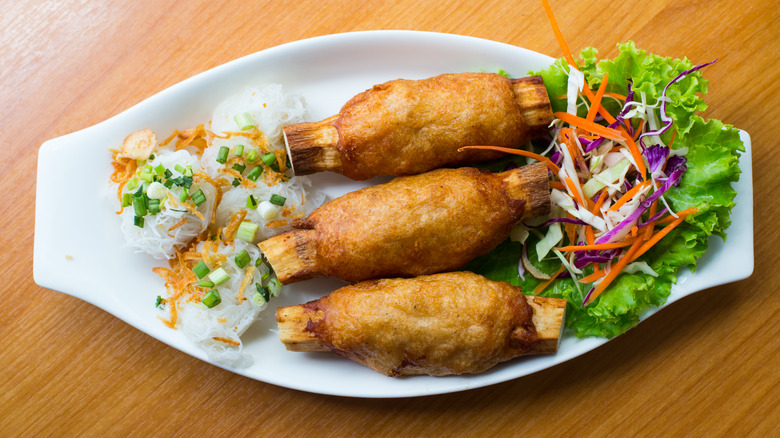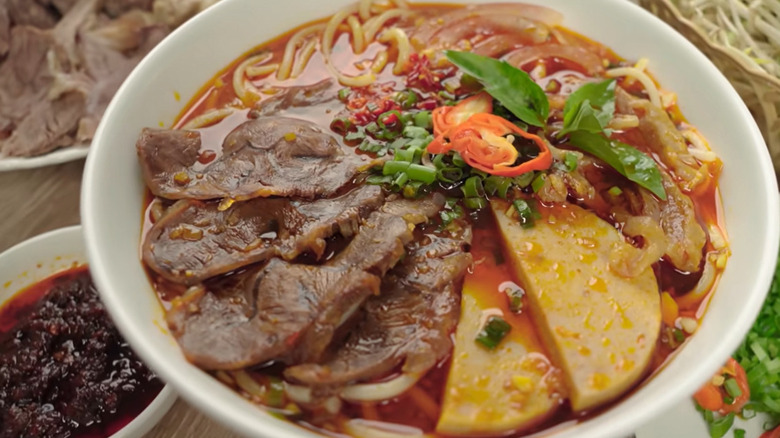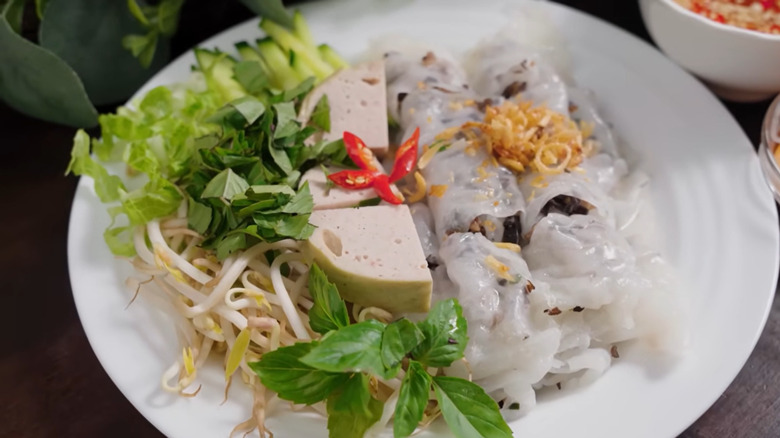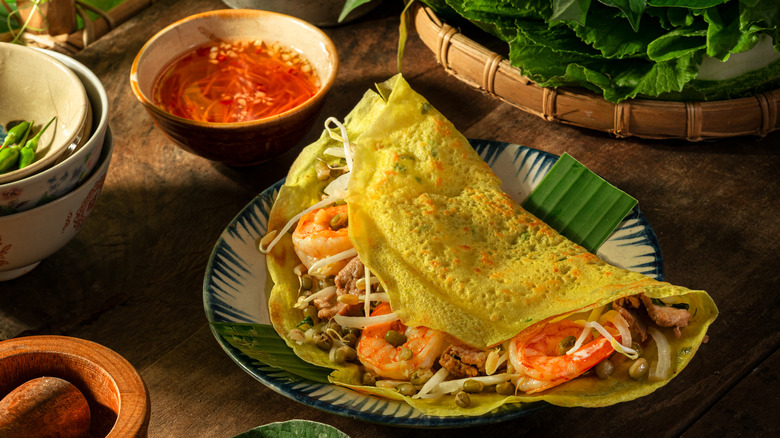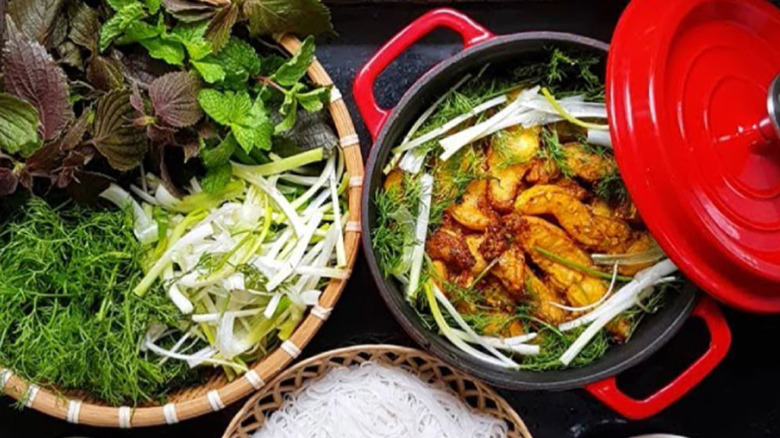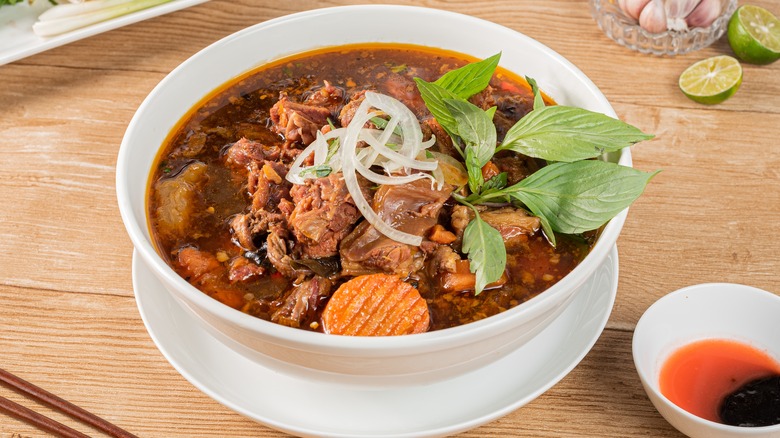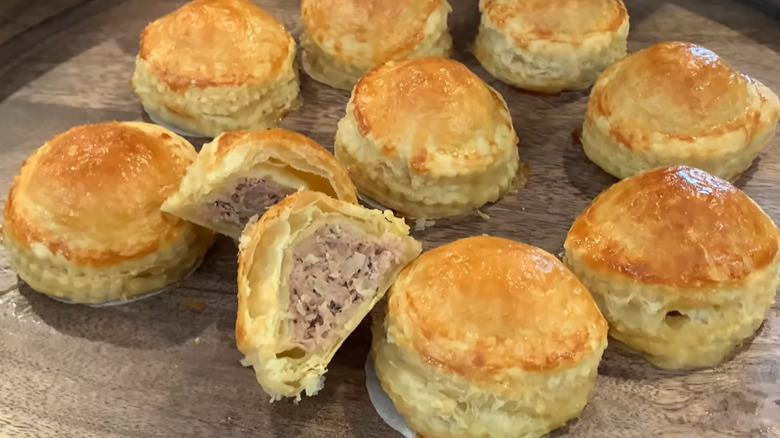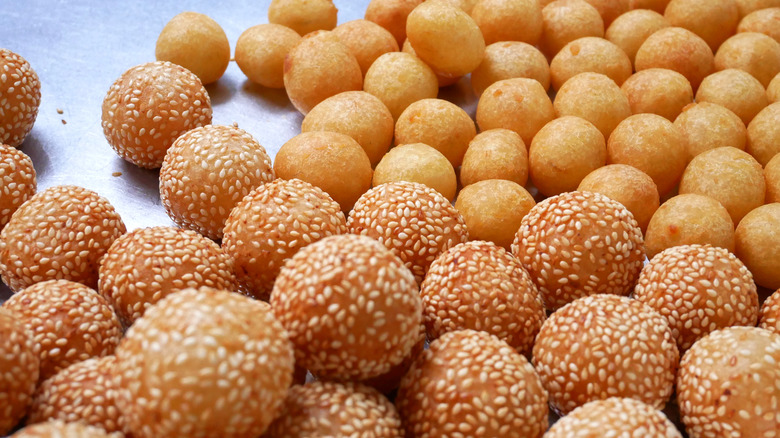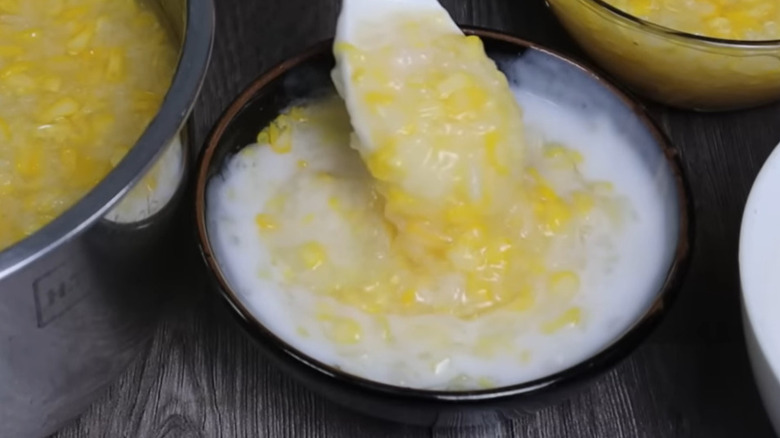15 Vietnamese Dishes You Need To Try At Least Once
Vietnamese cuisine is not as well known in the West as other Asian cuisines such as Chinese, Indian, and Japanese. And that's a shame because there are tons of unique flavors, textures, and colors that people are missing out on! Vietnamese cooking uses what is known as the Xu Wing and Mahābhūta principles, meaning each dish attempts to create a balance between the five fundamental tasting experiences of sweet, tart, salty, bitter, and spicy.
Even within Vietnam, there is regional variance, most notably between the north, south, and central regions. In addition, parts of southern Vietnam were under colonial rule by the French, including what is now Vietnam's largest municipality Ho Chi Minh City (also known as Saigon), during the 19th and 20th centuries. This left indelible marks on the country's foodscape. If you aren't intrigued yet, perhaps one of the 15 classic Vietnamese dishes detailed below, which range from soup through dessert, will entice your palate. Chúc ngon miệng! (That's Vietnamese for bon appétit.)
1. Pho
Phở (pronounced "fuh") is probably most Westerners' introduction to traditional Vietnamese food. It is the national dish of Vietnam, so it's an appropriate beginning. The basic ingredients are broth, rice noodles, protein (plant- or animal-based), and an array of toppings, such as crunchy raw bean sprouts, fresh herbs, or chilis, making it a versatile dish that can be made to taste.
Some have argued that the broth is an influence of French culture while the rice noodles show a Chinese influence. Both cultures have a history of invading the region. But everyone can agree that phở is 100% Vietnamese. Southern Vietnam phở tends to have a richer broth than phở native to the north of the country. There are even styles of phở that forgo the broth altogether. The protein most often used is beef, and the broth is made from beef bones simmered with spices such as cardamom, cinnamon, clove, coriander, fennel seed, and star anise. All of these flavors join together into a distinct flavor that is not to be missed.
2. Banh mi
The bánh mì (pronounced "BUN-mee") is another Vietnamese dish that has become slowly embraced by Westerners. Made with a baguette, these Vietnamese sandwiches have French roots. French colonizers brought with them typical French-style sandwiches such as the jambon-beurre (ham and butter on a baguette). Because they are quick to assemble, they are also a common street food.
As with phở, you will find variations in the toppings piled together to create a bánh mì. But the ingredients tend to fall into these five categories: a spread, such as butter or mayonnaise; a protein, such as liver pate, sliced meats, or even egg; fresh vegetables; pickled vegetables; and condiments like fish sauce, soy sauce, or Maggi seasoning sauce.
In Ho Chi Minh City which is said to be the birthplace of the sandwich, bánh mì tends to be piled high with meat. In Hoi An, on the other hand, there is more variety, with vegetables and eggs sometimes taking center stage. No matter the toppings, a bánh mì is perhaps the perfect way to experience the harmonious marriage of the five tastes, sweet, tart, salty, bitter, and spicy, emphasized in Vietnamese cuisine.
3. Bun cha
Bún chả (pronounced both "boon kah" and "boon chah") is another Vietnamese street food that was made famous in the United States by food celebrity Anthony Bourdain and former president Barack Obama. The two met up at Hanoi restaurant Bún Chả Hương Liên to share a meal in 2016. Hanoi is said to be the birthplace of bún chả, but it is a popular dish that is served in other northern Vietnamese cities as well.
Translated into English, bún chả literally means rice vermicelli and minced meat. The default meat is pork, but sometimes you will also see bún chả made from other meats. As a dish, however, bún chả is a bowl of grilled pork, pickled vegetables, and a little broth. The noodles are served on the side so that they don't absorb the broth. They can be eaten plain or dipped into the broth and eaten with the meat. The broth is usually spicy, so if you prefer a milder heat, be sure to ask for your bún chả without chili pepper.
4. Goi cuon
Gỏi cuốn (pronounced "goy coon") are literally "salad rolls," or spring rolls as we call them in the West. They are a popular inexpensive snack sold by street food vendors in Vietnam.
While there are variations, the most popular gỏi cuốn you will find are made up of pork, shrimp, rice noodles, and fresh salad vegetables such as lettuce, cabbage, carrots, and cucumber. Herbs like cilantro and mint may also be used. Once the ingredients have been assembled, they are rolled in a rice paper wrapper. The completed rolls are then served with a salty, sweet and sour dipping sauce.
Gỏi cuốn are not fried, but a fried version of Vietnamese spring rolls does exist called chả giò (pronounced "cha joe" or "cha yo"). It is the bright colors of the fresh vegetables and the outline of shrimp showing through the thin rice wrapper is what really makes gỏi cuốn stand out. It really is like eating an entire fresh salad in one simple, handheld package.
5. Rau muong xao toi
A delicious Vietnamese vegetarian dish is rau muống xào tỏi (pronounced "r-ow m-ooung sow th-oi"), or in English, stir-fried morning glory with garlic. Also (erroneously) called water spinach or swamp spinach, rau muống is part of the morning glory family. But it is the hollow stems and leaves rather than the flowers that are eaten. This fast-growing semi-aquatic plant grows all over Southeast Asia, where it is a popular culinary ingredient in more than Vietnamese cuisine.
The flavor and consistency resemble spinach, though morning glory stems are more substantial. The taste is less bitter than spinach can sometimes be. The sautéed garlic and a slight bite and a little sweetness. If you are a fan of cooked greens, and spinach in particular, then stir-fried morning glory with garlic should definitely be on your must-try list. Enjoy it alongside a bowl of hot steamed white rice.
6. Suon nuong
If your mouth waters at the mention of pork chops, then we have the Vietnamese dish for you. Sườn nướng (pronounced "sun nyung," with the U in "sun" halfway been sun and soon) literally translates to pork ribs. The chops are first marinated for a minimum of 3 hours in a mixture of lemongrass, shallots, and garlic then grilled until tender and juicy. The marinade makes this a pleasantly aromatic dish.
Sườn nướng is typically served with steamed rice and vegetables such as lettuce, tomatoes, and cucumbers, on the side. Sometimes you will also see it with a fried egg on top or may request it with one. As with many other Vietnamese dishes, there is often also a simple optional dipping sauce. These marinated grilled pork chops served with what is essentially a side salad make sườn nướng a very accessible dish to Westerners unused to Asian food. You may also see this called cơm sườn nướng on restaurant menus. Cơm (pronounced "gum") means cooked rice, so this just ensures that your grilled pork chops will come with rice.
7. Chao tom
Fans of sweet and savory snacks take notice. Chạo tôm (pronounced "chow toh-m") is a favorite of central Vietnam, but it is available all over the country. It translates to either fried shrimp or shrimp rice, depending on which dictionary you use. But that is only the beginning of this unique appetizer that is often served at weddings and other special occasions. Or enjoy it anytime because you love it!
A kind of paste is created from shrimp, pork, sugar, and other seasonings, then it is packed around a skewer of sugar cane. The whole thing is then deep-fried until golden, releasing a wonderful aroma. Another way you will sometimes see it is coated in panko bread crumbs before being deep fried. To eat it, you remove the meat from the skewer. Some people immediately discard the skewer while others chew or suck on the cane to extract its sweet juices.
8. Bun bo Hue
Bún bò Huế (pronounced "boon bo way") is a beef noodle soup unique to Vietnam's old capital Hue, located along the north-central coast. Despite the name, there is a lot more than beef in this soup. The rich, reddish-orange broth is spicy and smells pleasantly of lemongrass. What really stands out about this dish are the slices of beef, pig trotters, and congealed pig's blood. Shrimp paste is also essential for a true Hue experience. Also commonly included in the bowl of noodle soup are bean sprouts, banana blossoms, various herbs, and a wedge of lime.
To some, this may sound like a strange combination of ingredients, but it embodies the many types of flavors found in Vietnamese cuisine, and is a total regional specialty. If you find yourself in Hue, you have to give it a try. And if you find it on a menu outside of Hue, pat yourself on the back for a good find, and place your order.
9. Banh cuon
You may notice that bánh has already appeared on this list, and it won't be the last time you see it. That's because it means so many different things. One translation is cake, but not necessarily cake in the way English speakers mean cake. It can also mean bread, as in the already mentioned bánh mì. Basically, if a food contains flour of any kind, it can be called bánh.
Bánh cuốn (pronounced "bun coon") literally means rolled cake. There are two ways of making Bánh cuốn, steaming or frying. When streaming, special bánh cuốn steamers exist just for this. For frying, a batter of mostly rice flour is poured into a pan to create a thin crêpe-like bánh that is then filled with things like minced pork, onion, jícama, mushrooms, and raw and pickled vegetables. This offers a variety of flavors as well as textures to sink your teeth into. The ingredients are then rolled up, hence the rolled cake.
10. Banh xeo
We told you that you would encounter the word bánh again. The xèo in bánh xèo (pronounced "bun say-oh") is from the sound that the batter makes when it is added to the hot pan. In English, we might say sizzle, making this a sizzle cake or sizzle bread.
The origins of bánh xèo are not totally clear, but they have been a popular street food in Vietnam for many years. In more recent years, they even made their way onto the menus of high-end restaurants. These thin, savory pancakes, which range from hand size to two or three times that length, are made from rice flour and fried to a golden crisp. Any number and variety of fillings may be laid on the bánh xèo before it is folded in half, rather like a quesadilla or an omelet. Seafood as well as ground pork are popular fillings along with vegetables such as bean sprouts, mung beans, and even some fruits. Different regions like to show off their local produce. And, of course, there is a dipping sauce served on the side.
11. Cha ca La Vong
Chả cá Lã Vọng (pronounced "chah kah lah voh-ng") is named after the restaurant in Hanoi that launched its success in the latter 19th century when Vietnam was still under French colonial rule, and continues to operate today. The Doan family served chả cá Lã Vọng, also known as just chả cá to the locals, to the French soldiers. It was deemed so delicious that the family was urged to open their own restaurant, thus Chả cá Lã Vọng was born. Once other nearby restaurants began to copy the dish, the street was eventually named after it!
Chả cá means grilled fish, and Lã Vọng was a politician who started his life as a fisherman, becoming a symbol of diligence and hard work. Chả cá Lã Vọng is made with fish that has been marinated in turmeric, garlic, shallots, galangal, salt, sugar, and fish sauce. Traditionally, the fish is sautéed at the customers' table and spooned over bowls of noodles and vegetables, making this dish very much a restaurant experience as opposed to street food. The texture of the tender fish contrasts nicely with the crunch of fresh vegetables.
12. Bo kho
Bò kho (pronounced "baw caw") means beef stew. It may be spicy or not spicy. Like sườn nướng (grilled pork chops) mentioned above, bò kho is a good entry point for Westerners who wish to try Vietnamese cuisine.
In its most basic parts, this beef stew is made up of cuts of beef slow-cooked with root vegetables like carrots, onion, and various aromatics such as garlic and paprika. The broth is tomato-based, giving it a dark red color. What makes it distinctly Vietnamese are the lemongrass, ginger, powdered anise, cloves, cilantro, and Thai basil garnishes. There is also an optional dipping sauce served on the side made of salt, ground black pepper, and lime or lemon juice. The soup is sometimes ladled over flat rice noodles or a bowl of steamed rice, and it is served with a baguette. If you see Hủ Tiếu Bò Kho (roughly pronounced "ho-ooh teh-yoo") on a restaurant menu, know that it is beef stew with rice noodles.
13. Banh pate so
Bánh patê sô, also spelled pâté chaud, (both pronounced "pah-tay show") are very much a remnant of French colonization. Pâté chaud is French for hot paste, a reference to the minced meat filling. These crispy, savory little meat pastries are also pretty darn delicious and recommended as a perfect snack to enjoy with a cup of Vietnamese coffee. They are also ideal to serve at parties or keep in the fridge as a quick treat.
If you visit a Vietnamese coffee shop, you may see patê sô on the menu, but they are also quite easy to make at home if you'd like to give them a try yourself. The outside is puff pastry, and the filling can be made from any number of things. Ground pork is traditional, but don't let that deter you from trying beef, chicken, or a vegetarian patê sô. Other filling ingredients include mushrooms, onions, shallots, fish or oyster sauce, and various herbs and seasonings.
14. Banh cam
Bánh cam (pronounced "bun kahm"), also known as bánh rán (pronounced "bun ren") in northern Vietnam, are sesame balls. Bánh rán, which translates to fried cake, is also sometimes translated as doughnut. Bánh cam means orange cake, a reference to its golden color and round shape.
You may have seen these before in Asian bakeries. A sweet paste made from mung beans is surrounded by glutinous rice flour and formed into a ball. The ball is covered in raw sesame seeds, and then deep fried. The crispy sesame seeds and outer shell of the dough create a satisfying contrast to the soft, sweet paste inside. This is a treat that you can really sink your teeth into.
In northern Vietnam, it is customary to have bánh rán with a sugar syrup drizzled over the top. Another difference between the northern and southern varieties is that in the south, bánh cam does not contain Jasmine flower essence while bánh rán does.
15. Che bap
We had to finish on a sweet note. Chè bắp (pronounced "chay bop") is a sweet corn pudding. And we don't mean the baked bread-like corn pudding found in the United States. Vietnamese sweet corn pudding is more like what Americans think of when they hear the word pudding, a semi-liquid sweet dessert eaten with a spoon. Chè actually means sweet soup, and bắp means corn.
The main ingredients for the pudding (or soup) are sweet corn, glutinous rice, water, and sugar. Sometimes pandan leaves are also added for a distinct floral aroma and flavor. Chè bắp is often served with a topping made from coconut milk, but for those who don't like coconut, it isn't a necessary ingredient to enjoy the pudding. Northern Vietnam has a similar corn pudding that is less sweet called chè ngô (pronounced "chay noh"). Given how ubiquitous sweet corn is in North America, how can anyone not want to give either of these a try?
